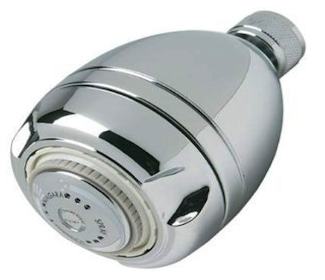Low Flow Show Heads
Using less water should be at the top of the list for anybody looking to lower their environmental impact. Efficient water usage is also a requirement for any home wishing to be labeled as 'green'.
Luckily, saving water is easy and inexpensive; using less water can lower utility costs substantially, often paying back any investment in water-saving equipment in a very short amount of time.
One of the largest sources of water usage in any home is the shower. While showers typically use less water than taking a bath, there is lots of room to improve efficiency. Bathing uses 17 percent of a household's water usage; switching to a low flow showerhead can lower water consumption by the shower by 50% or more.
Everybody loves a nice hot shower (well, everybody I know). But all of those long showers use a lot of water. Obviously, shortening the length of one's showers is a great way to cut water usage, but choosing the right showerhead can cut water usage in the shower just as dramatically, often saving hundreds of dollars a year.
Introducing The Water Saving Showerhead
Showerheads are measured by water flow, the number of gallons they deliver per minute (gpm). A home's water pressure, measured in pounds per square inch (psi) can greatly affect the amount of water coming out of the showerhead, but the showerhead itself can greatly affect the gpm.
The average showerhead of just a decade or so ago used from 5 to 8 gpm. In the 1990s, companies introduced low-flow showerheads in order to meet new, stricter guidelines for water usage. The current standard is 2.5 gpm at 80 psi, although some newer models use as little as half a gallon per minute.
You can identify your current showerhead's flow rate by placing a gallon container under it and time how long it takes to fill. If it takes 10 seconds, the flow rate is about 6 gpm. A standard low-flow showerhead should take 24 seconds or more. If your showerhead takes less than 24 seconds to fill a gallon container, it's time to consider replacing it.
Choosing a Water Saving Showerhead
A quality low flow showerhead will save money and water; but nobody wants a showerhead that produces an unsatisfactory stream of water. Many early low flow models produced water streams that were unacceptable to many consumers, and like the earliest low-flow toilets, led to a bit of a backlash. Today, there are many different styles of water saving showerheads available from manufacturers, and at a variety of price points to fit any budget.
The price for low-flow heads can range from under $10 to over $100 for fancier designer heads with more features. The cost is usually an indicator of features and finish more than water output. Very simple, inexpensive showerheads costing $10 can produce a strong, satisfactory stream using only 1 or 1.5 gpm. Keep in mind, whatever the cost of a new low flow showerhead is, even if it's pricey, that cost is often paid back within a year with lower water and water-heating bills.
Hand-held water saving showerheads usually cost a bit more, but offer more convenience and versatility than their stationary counterparts. More expensive units also have adjustable spray settings, such as pulse, massage, wide spray, etc.
One important feature to look for in aware saving showerhead is a shutoff switch. This water-saving feature allows the water stream to be turned down to a trickle or off entirely while you soap up or shave.
Look for the WaterSense label on any showerhead you choose; it's the proof that the unit has been independently tested for efficiency and quality.
Choosing the right showerhead is personal; everybody has different ideas of what the perfect shower is. The important criteria is how much water it uses; choose one that uses the least amount of water possible while still providing a satisfactory shower experience.
comments powered by Disqus


























































































































































































